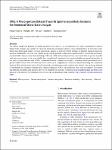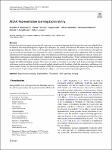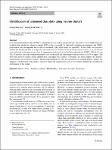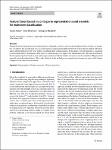Search
Author
- Osman, Ahmed I. (5)
- Daqing, Ma (3)
- Jorgensen, Ed (3)
- Li, Yan (3)
- next >
Subject
- kinh tế (26)
- Economics (12)
- programming (10)
- XRD (10)
- next >
Date issued
- 2020 - 2025 (2128)
- 2010 - 2019 (129)
- 2000 - 2009 (9)
- 1999 - 1999 (1)
Has File(s)
Search Results
We consider the time discretization of a linear parabolic problem by the discontinuous Galerkin (DG) method using piecewise polynomials of degree at most r − 1 in t, for r ≥ 1 and with maximum step size k. It is well known that the spatial L2-norm of the DG error is of optimal order kr globally in time, and is, for r ≥ 2, superconvergent of order k2r− 1 at the nodes. We show that on the n th subinterval (tn− 1,tn), the dominant term in the DG error is proportional to the local right Radau polynomial of degree r. This error profile implies that the DG error is of order kr+ 1 at the right-hand Gauss–Radau quadrature points in each interval. We show that the norm of the jump in the DG solution at the left end point tn− 1 provides an accurate a posteriori estimate for the maximum error ... |
Hybrid platforms combining multicore central processing units (CPU) with many-core hardware accelerators such as graphic processing units (GPU) can be smartly exploited to provide efficient parallel implementations of wireless communication algorithms for Fifth Generation (5G) and beyond systems. Massive multiple-input multiple-output (MIMO) systems are a key element of the 5G standard, involving several tens or hundreds of antenna elements for communication. Such a high number of antennas has a direct impact on the computational complexity of some MIMO signal processing algorithms. In this work, we focus on the channel estimation stage. In particular, we develop a parallel implementation of a recently proposed MIMO channel estimation algorithm. Its performance in terms of execution... |
Medical instrument detection is essential for computer-assisted interventions, since it facilitates clinicians to find instruments efficiently with a better interpretation, thereby improving clinical outcomes. This article reviews image-based medical instrument detection methods for ultrasound-guided (US-guided) operations. Literature is selected based on an exhaustive search in different sources, including Google Scholar, PubMed, and Scopus. We first discuss the key clinical applications of medical instrument detection in the US, including delivering regional anesthesia, biopsy taking, prostate brachytherapy, and catheterization. Then, we present a comprehensive review of instrument detection methodologies, including non-machine-learning and machine-learning methods. |
We explore using body gestures for hidden emotional state analysis. As an important non-verbal communicative fashion, human body gestures are capable of conveying emotional information during social communication. In previous works, efforts have been made mainly on facial expressions, speech, or expressive body gestures to interpret classical expressive emotions. Differently, we focus on a specific group of body gestures, called micro-gestures (MGs), used in the psychology research field to interpret inner human feelings. MGs are subtle and spontaneous body movements that are proven, together with micro-expressions, to be more reliable than normal facial expressions for conveying hidden emotional information. In this work, a comprehensive study of MGs is presented from the computer ... |
The study of natural and human-made processes often results in long sequences of temporally-ordered values, aka time series (TS). Such processes often consist of multiple states, e.g. operating modes of a machine, such that state changes in the observed processes result in changes in the distribution of shape of the measured values. Time series segmentation (TSS) tries to find such changes in TS post-hoc to deduce changes in the data-generating process. TSS is typically approached as an unsupervised learning problem aiming at the identification of segments distinguishable by some statistical property. Current algorithms for TSS require domain-dependent hyper-parameters to be set by the user, make assumptions about the TS value distribution or the types of detectable changes which li... |
Despite the significant improvements that self-supervised representation learning has led to when learning from unlabeled data, no methods have been developed that explain what influences the learned representation. We address this need through our proposed approach, RELAX, which is the first approach for attribution-based explanations of representations. Our approach can also model the uncertainty in its explanations, which is essential to produce trustworthy explanations. RELAX explains representations by measuring similarities in the representation space between an input and masked out versions of itself, providing intuitive explanations that significantly outperform the gradient-based baselines. |
The risk-based access control model is one of the dynamic models that use the security risk as a criterion to decide the access decision for each access request. This model permits or denies access requests dynamically based on the estimated risk value. The essential stage of implementing this model is the risk estimation process. This process is based on estimating the possibility of information leakage and the value of that information. Several researchers utilized different methods for risk estimation but most of these methods were based on qualitative measures, which cannot suit the access control context that needs numeric and precise risk values to decide either granting or denying access. Therefore, this paper presents a novel Adaptive Neuro-Fuzzy Inference System (ANFIS) mod... |
Nearest neighbour similarity measures are widely used in many time series data analysis applications. They compute a measure of similarity between two time series. Most applications require tuning of these measures’ meta-parameters in order to achieve good performance. However, most measures have at least O(L2)
complexity, making them computationally expensive and the process of learning their meta-parameters burdensome, requiring days even for datasets containing only a few thousand series. In this paper, we propose ULTRAFASTMPSEARCH, a family of algorithms to learn the meta-parameters for different types of time series distance measures. These algorithms are significantly faster than the prior state of the art. Our algorithms build upon the state of the art, exploiting the prope... |
Convolutional neural networks (CNNs), a representative type of deep neural networks, are used in various fields. There are problems that should be solved to operate CNN in the real-world. In real-world operating environments, the CNN’s performance may be degraded due to data of untrained types, which limits its operability. In this study, we propose a method for identifying data of a type that the model has not trained on based on the neuron cluster, a set of neurons activated based on the type of input data. In experiments performed on the ResNet model with the MNIST, CIFAR-10, and STL-10 datasets, the proposed method identifies data of untrained and trained types with an accuracy of 85% or higher. The more data used for neuron cluster identification, the higher the accuracy; conve... |
Feature-level-based fusion has attracted much interest. Generally, a dataset can be created in different views, features, or modalities. To improve the classification rate, local information is shared among different views by various fusion methods. However, almost all the methods use the views without considering their common aspects. In this paper, wavelet transform is considered to extract high and low frequencies of the views as common aspects to improve the classification rate. The fusion method for the decomposed parts is based on joint sparse representation in which a number of scenarios can be considered. The presented approach is tested on three datasets. The results obtained by this method prove competitive performance in terms of the datasets compared to the state-of-the-... |










